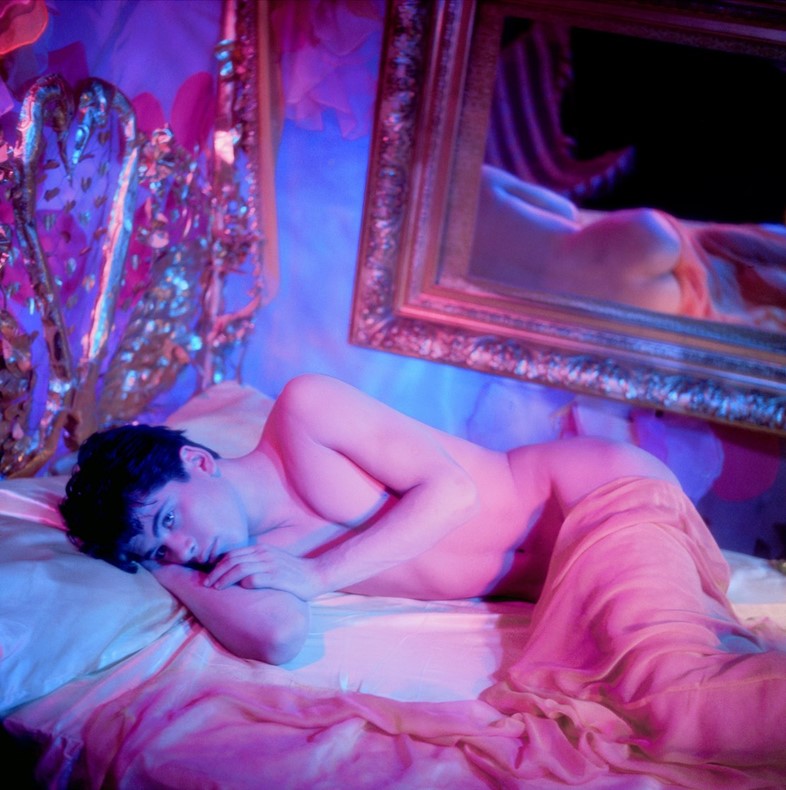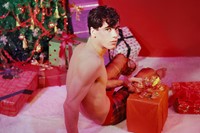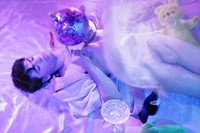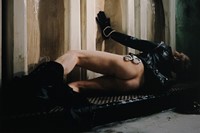As a new exhibition of previously unseen James Bidgood photographs opens in New York, Miss Rosen reflects on the life of an artist who found solace and sanctuary in the world of make-believe
When groundbreaking queer artist James Bidgood died in January at age 88 from complications due to Covid-19, he left behind a singular legacy that influenced a generation of artists including Pierre et Gilles and David LaChapelle. Possessed with uncompromising integrity, Bidgood lived as an openly gay man in New York at a time when homosexuality was still a crime. Whether working as a female impersonator, window dresser, fashion and costume designer, graphic designer, photographer, photo stylist, or filmmaker, Bidgood embraced glamour, fantasy and spectacle, crafting spellbinding technicolour tapestries of sensuality and desire.
A layered and complex man who refused to sell out, Bidgood was sharp, witty, and au courant. “Jim was hilarious and smart, but in the course of one meeting the tone could change quickly,” says gallerist Brian Clamp, who will be launching Unseen Bidgood: A Memorial Exhibition, Photographs by James Bidgood (1933-2022) on September 15 in New York. “He could be very pessimistic, angry, and upset but then on the turn of the dime, he could make another joke, crack himself up, and suddenly lift himself into a good mood. I learned over the course of the 20 years to sit back, be patient, and listen to what he had to say because he wanted to be heard.”
Indeed, Bidgood loved the power of performance and its ability to transform our prosaic world into a mystical reverie of beauty and charm. It’s a lesson he learned as a young boy growing up in the Midwest. Born in 1933 during the height of the Great Depression, Bidgood found solace and sanctuary in the world of make-believe, turning an old cereal box into a stage set for his paper dolls and casting them in lavish productions befitting a Hollywood extravaganza.
In 1951, Bidgood, then 18, hopped a Greyhound bus from Madison, Wisconsin, to New York – a city he would call home for the next 70 years. “Since I first saw a comic strip representation of a big city at night – black rectangular shapes cutting across the dark blue star-speckled night above with many little yellow rectangular shapes inside them like jars of honey – I had dreamed of coming to New York City and I knew for certain and for sure I would one day,” Bidgood told me in 2019.
“When I first saw the city skyline from out the greyhound bus I travelled here on … I knew I was home. The city was so clean, so bright and shiny then, the concrete sidewalks seemed embedded with glitter. They actually shimmered in the summer sun. They were not gold, they were more like studded with tiny diamonds. New York back then was exactly as it appeared to be in MGM musicals. It was fast and it was more exciting than your second orgasm. It was romantic, filled with wonderful warm-hearted people like old, Irish and always tipsy forgiving landladies collecting the rent every week or month, and that more or less sums it all up. The city had a heart then. It was human.”
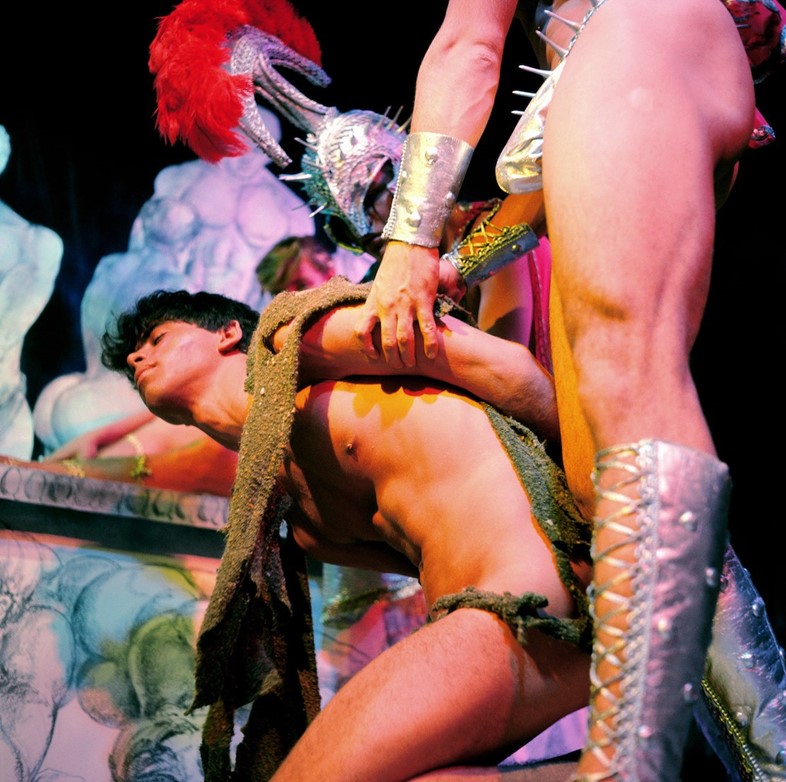
Over the next seven decades, Bidgood would become a pivotal force in the underground, shaping and reshaping the expression of LGBTQ+ identity before and after Stonewall. With dreams of becoming a Ziegfield Girl, Bidgood got his start performing as Terri Howe at Club 82, a legendary drag nightclub in the East Village frequented by luminaries like Elizabeth Taylor, Judy Garland, and Zsa Zsa Gabor. Although cross-dressing was illegal on any day other than Halloween, Bidgood would not be deterred. “I made my way by performing those tasks normally assigned to the fairies,” he said. “I did what the sissies were expected to do and fortunately for me, all I ever wanted to do.”
Bidgood brought his love of theatricality to his work designing costumes for society balls. He then secreted away the wisps of chiffon, taffeta, lace, feather, sequins, and glitter for his own productions cast in the privacy of his own home, transforming his midtown tenement into a photo studio. During the 1960s, he published his photos in Muscleboy, Adonis, and The Young Physique but went against type. At a time when homoerotic “fitness” magazines displayed tasty morsels of beefcake, carefully skirting the laws against the sales and distribution of full frontal male nudity, Bidgood embraced the feminine, ethereal energy of romance and mystery, fusing glamour photography and pulp aesthetics with a health splash of camp for pizzazz.
“A lot of it comes from what Jim was looking at: female pin-up photography,” Clamp says. “There was so much more artistry that interested him: the lighting was great, the costumes were wonderful, and there were stories in the photography. He was frustrated and perplexed as to why that had never been done with male models, and wanted to bring that to his photography.”

Inspired by artists like George Quaintance, Maxfield Parrish and Hans Richter, Bidgood explained, “I wanted to photograph naked young men as opulently and as attentively as those ladies appearing in Playboy-type magazines were photographed. No matter how crass the pose, they were lavishly costumed – often with what I would guess were hard-earned furs – and so carefully lit against expensive backgrounds, all probably styled by some out-of-work Bloomingdales basement clerk.”
Bidgood had an epiphany after watching a straight sex loop at a porn theater in Times Square when it was still the red light capital of the Eastern Seaboard. In the film, a woman performed fellatio while deftly draping a fine silk scarf over that which was deemed “obscene” by the courts. “As long as whatever was not nude it evidently was legal,” Bidgood remembered. “But legal or not, it seemed to me many times sexier and far more naughty than had it been bare. This was more or less something I had already realised. It is very often what you don’t see that is the greater turn-on because your mind fills in the blanks with what that particular viewer hopes they would discover.”
Inspired, Bidgood used a few fine fabrics he had saved from his couture projects and set to work on something properly befitting the bas monde. In the wake of the Stonewall Uprising, Bidgood created his masterpiece, the 1971 movie Pink Narcissus. Casting local hustlers in the film, he joyously embraced masculine tropes like the biker and the construction worker in the story, which followed the allegorical fantasies of a gay prostitute. The movie went on to achieve cult status, but Bidgood’s work went unrecognised for decades, for he had removed his name from the credits following creative differences with the film’s producer.
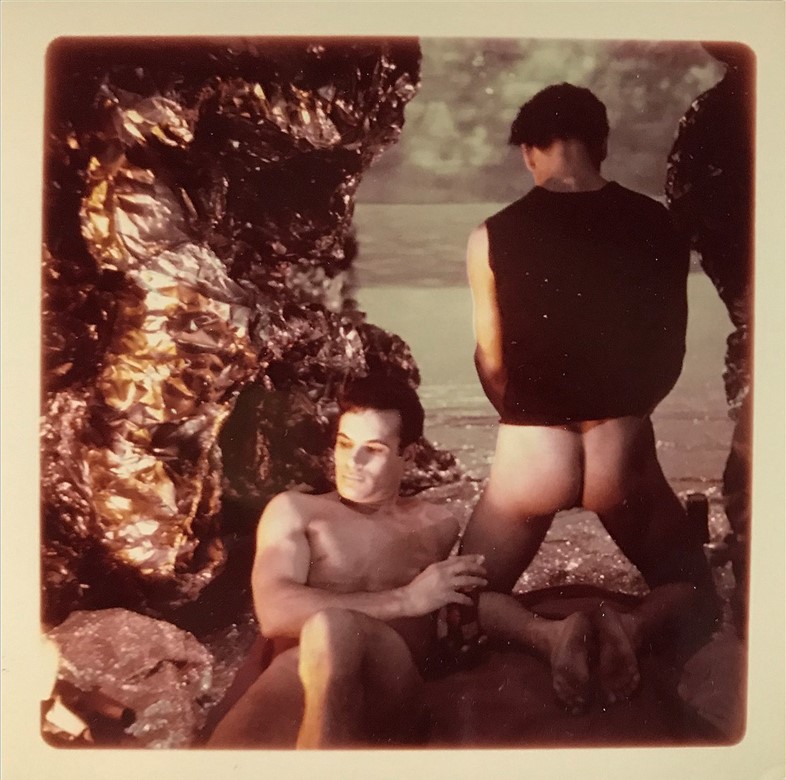
He continued to work in obscurity until writer Bruce Benderson located him and helped produce Bidgood (Taschen), the artist’s first complete monograph in 1999. The book arrived at the perfect time, just as photography, pop culture, and fashion found their way into the brand new heart of the New York art world: Chelsea. Clamp, then a young art dealer, remembers the era clearly. “Chelsea was starting to take off and it was a good time for Jim to begin selling limited edition prints of his artwork,” he says. “There was a cultural shift as people weren’t so afraid of homoerotic photography. There was an appreciation for the work and its worth as an investment, and Jim was able to have a renewed career.”
Throughout his life, Bidgood remained uncompromising, preferring to live on his own terms rather than compromise and sell out – a gamble that paid off by playing the long game. By the late 1990s, conceptual staged photography was also coming into vogue as the world of Gregory Crewdson and David LaChapelle dominated the fine art and commercial photography worlds. Sexuality, once seen as a provenance of pornography even when there was not actual sex depicted, was finally being embraced by the art world, and Bidgood’s 1960s work could be understood in its own right.
“Jim never censored himself,” Clamp says. “But there was one sensitive topic: his home. Towards the end of his life, I was no longer allowed in his apartment. I don’t know if there was shame there, or just acknowledgement I might be uncomfortable. He would be waiting for me outside his front door in a chair with a TV tray set up in the hallway and that’s where we would hold our meetings. After he passed away, we cleaned out his apartment and I was impressed by how organised the chaos actually was. There was a container for glitter, one for sequins, another for baby heads – and the key was he knew where everything was. He had his workspace: a chair and a computer with a light hanging over it, and that space was sacred. It seemed to be the most important spot.”
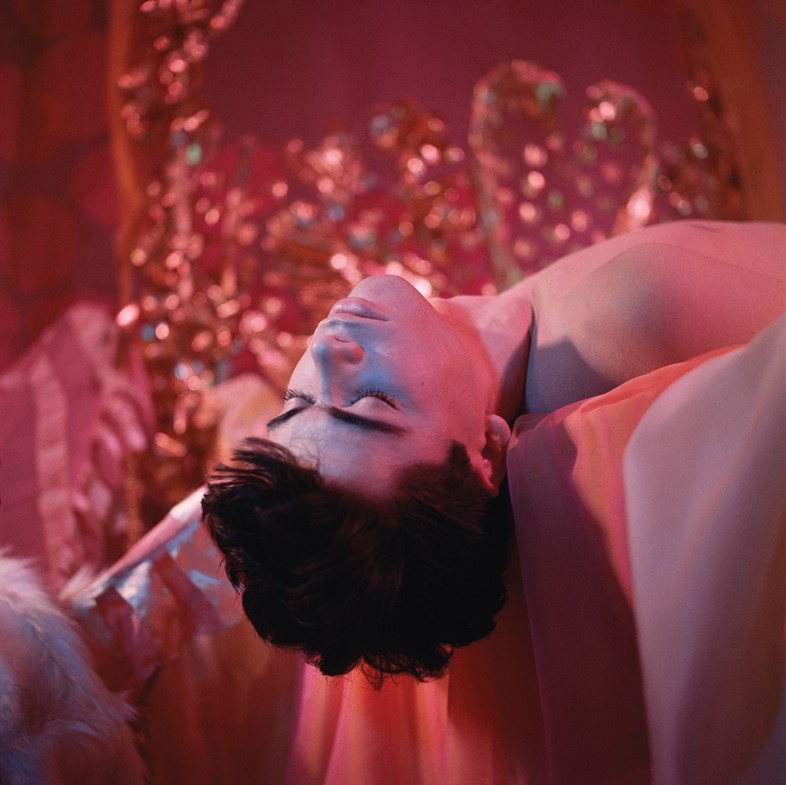
Looking back on his life, Bidgood recognised that artmaking in and of itself was life’s great reward. “Being creative is not about praise or gratitude; it is only about the act of creating. Of course if your art gets attention and puts money in the pot so that you can afford to continue realising those visions that dance in your head, great – but art only stimulated by praise or profit is not art,” he said. “If it is not born from pain or anguish or pride or shame or desire or overwhelming joy, if it is not the wanting to share this emotional catharsis, it is only something of decorative value. Art is not painting by numbers. Art is not vaudeville. One does not even need [to] be a very fine craftsman. It does require a kind of vulnerability and the ability to expose your need no matter what. You have to feel art; it demands a physical response.”
Unseen Bidgood: A Memorial Exhibiiton, Photographs by James Bidgood (1933-2022) is on view at CLAMP in New York until 29 October 2022.
